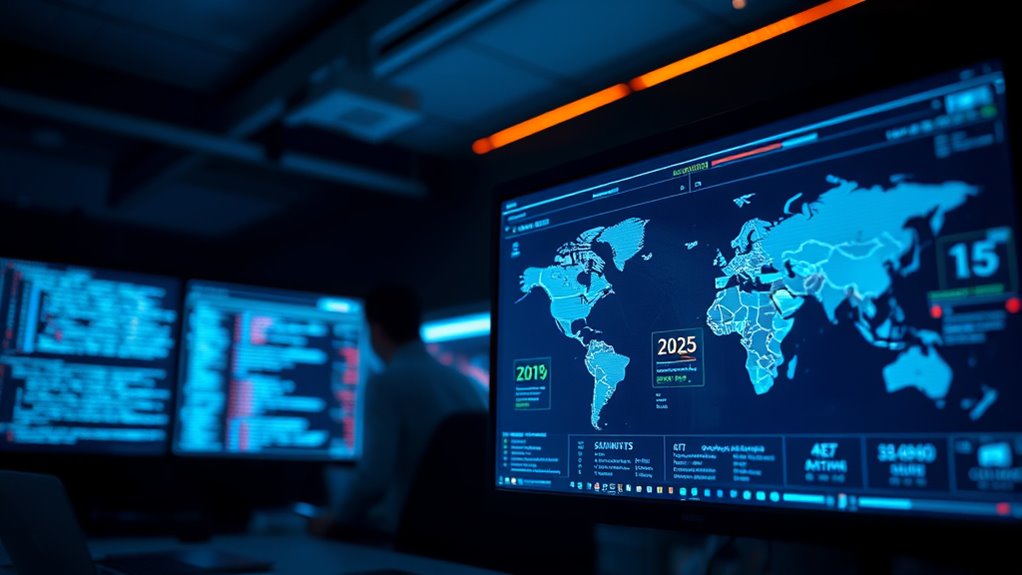In 2025, over 23 million people have been affected by data breaches across various sectors, with personal, medical, and financial information exposure at an all-time high. Attack methods like phishing, credential theft, and supply chain vulnerabilities remain common, mostly targeting network servers and third-party vendors. Human errors and insider threats also play significant roles. If you want to understand how these breaches occur and what’s being done to prevent them, keep exploring the details.
Key Takeaways
- In 2025, numerous breaches impacted millions, including a significant incident affecting 23 million individuals’ SSNs.
- The breach involving 23 million individuals primarily involved personal information like SSNs and other PII.
- Supply chain vulnerabilities and hacking attacks are common causes of large-scale breaches in 2025.
- The incident raised substantial privacy concerns and prompted increased regulatory scrutiny across sectors.
- Organizations are adopting AI-driven detection and enhanced security measures to prevent future large-scale breaches.
Overview of Data Breach Trends in 2025

In 2025, data breach trends reveal a persistent and escalating threat landscape, with high incident volumes and significant impacts. You’re likely to see around 1,700 reported breaches in the first half alone, affecting over 165 million people. Despite efforts, victim notification rates remain low, with just 12.2% of victims informed, leaving many unaware of their exposure. Breaches continue to grow in scale and severity, driven by sophisticated cyberattacks like phishing, supply chain breaches, and insider threats. Hacking remains the dominant cause, especially targeting network servers. The financial and reputational costs are rising, and organizations struggle to respond quickly due to gaps in security automation. Overall, the 2025 landscape shows a troubling trend of frequent, large-scale breaches with widespread consequences. Incorporating security best practices and ongoing training is crucial for organizations aiming to mitigate these evolving threats. Additionally, the rise of AI-driven attack methods underscores the need for advanced defensive strategies to keep pace with cybercriminal innovations. Continuous monitoring and threat intelligence sharing are essential components for enhancing organizational resilience against such attacks.
Healthcare Sector: Major Incidents and Vulnerabilities

You’ll notice a sharp rise in healthcare breaches this year, with nearly 500 incidents affecting over 37 million people. Cyberattacks, especially hacking and IT failures, dominate the sector, exposing critical vulnerabilities. Understanding these major incidents helps you see where defenses need strengthening to prevent future breaches. Additionally, the increasing sophistication of cyber threats emphasizes the importance of cybersecurity vulnerabilities and proactive security measures in safeguarding sensitive health data. Implementing comprehensive security protocols and regular system updates are vital to reduce the risk of such breaches. Exploring the latest Kia Tuning enhancements can also serve as a reminder of how important it is to keep systems optimized and secure from potential vulnerabilities. Moreover, staying informed about entertainment support hours, such as those for PlayStation or theme parks, can help organizations prepare for potential disruptions during critical updates or high-traffic periods. Recognizing the role of system vulnerabilities in these breaches underscores the need for ongoing staff training and awareness.
Surge in Healthcare Breaches
The healthcare sector experienced a significant surge in data breaches in 2025, with nearly 500 incidents reported so far. These breaches have compromised over 37.5 million individuals, averaging 76,000 per breach. Most attacks are driven by hacking (78%), with network servers being the primary target (58%). Third-party vendors account for 37% of incidents, exposing supply chain vulnerabilities. The table below highlights breach characteristics:
| Aspect | Details | Impact |
|---|---|---|
| Major Cause | Phishing (16%) | $4.8 million average cost |
| Common Location | Network servers (58%) | Data exposure and operational risk |
| Primary Victims | Patients (76%) | Sensitive PII and PHI |
| Responsible Parties | Healthcare providers (76%) | Insider and external threats |
| Data Types Affected | Personal (37%), medical (13%) | Increased privacy concerns |
This surge underscores the sector’s ongoing vulnerabilities and the need for strengthened defenses. Additionally, implementing robust security protocols can play a vital role in mitigating future breaches. Recognizing the importance of vulnerability management is critical in addressing these persistent threats. Strengthening cybersecurity practices within healthcare organizations is essential to reduce the risk of future incidents. As cyber threats evolve, continuous threat monitoring remains a key component of effective defense strategies. Enhancing incident response plans can also help organizations minimize damage when breaches occur.
Cyberattack Dominance in Sector
Despite increased awareness and security efforts, cyberattacks continue to dominate the healthcare sector, causing major incidents that expose sensitive data and disrupt operations. You face persistent threats like hacking, phishing, and supply chain attacks, which account for most breaches. Network servers remain the primary target, with over half of breaches involving them, often linked to third-party vendors. Human errors and IT failures contribute substantially, exposing vulnerabilities you must address. Attackers increasingly exploit credentials—used in more than half of all breaches—highlighting the importance of strong authentication. Major incidents, such as LexisNexis and Texas HHS breaches, reveal how cybercriminals target PII and PHI, impacting millions. The sector’s vulnerabilities demand ongoing vigilance, robust security practices, and proactive measures to mitigate the relentless cyberattack dominance. Implementing targeted security measures can significantly reduce the risk of future breaches and protect sensitive information. Additionally, investing in cybersecurity training for staff can help minimize human errors that lead to breaches. Incorporating AI security solutions can further enhance threat detection and response, safeguarding healthcare data more effectively.
Notable Breach Cases and Their Impact

What makes certain breach incidents stand out in 2025 is their profound impact on individuals and organizations alike. The LexisNexis breach exposed sensitive details like SSNs and driver’s licenses for over 364,000 people, risking identity theft. The onsite mammography breach compromised PII and PHI of more than 350,000 patients, disrupting healthcare delivery. Texas HHS data accessed by employees affected 94,000 people, highlighting insider threats. In South Korea, SK Telecom’s leak damaged both corporate reputation and customer trust. The April breaches, leaking 4 million SSNs, impacted 23 million individuals, leading to widespread concern about privacy. These cases underscore the severe consequences of cyberattacks, including financial loss, reputational damage, and increased regulatory scrutiny, emphasizing the critical need for stronger security measures and rapid response strategies. Additionally, these incidents highlight the importance of cybersecurity best practices to mitigate future risks.
Common Causes and Attack Vectors Exploited

You should be aware that phishing remains the leading attack method, accounting for 16% of breaches and causing significant financial damage. Supply chain vulnerabilities are also a major concern, with attackers exploiting third-party systems to access sensitive data. Additionally, credential theft occurs in over half of all breaches, making it essential to protect user login information. Implementing comprehensive meal prep strategies can help organizations establish secure data handling practices and reduce vulnerabilities. Recognizing the importance of security enhancements in safeguarding systems is crucial for defending against evolving threats. Regular system updates and patch management are vital components of an effective security posture to prevent exploitation of known vulnerabilities. Furthermore, understanding cookie management is essential for maintaining user trust and complying with privacy regulations. Staying informed about the latest threat intelligence can also significantly improve an organization’s ability to anticipate and mitigate cyber attacks.
Phishing as Primary Method
Phishing remains the most common method attackers rely on to breach organizations in 2025, exploiting human vulnerabilities to gain access. You might receive convincing emails that look legitimate, prompting you to click malicious links or share sensitive info. Attackers often:
- Pose as trusted contacts or companies, creating urgency to prompt quick action.
- Use convincing logos and language to mimic official communications, lowering suspicion.
- Link to fake login pages that harvest credentials when entered.
These tactics exploit your trust and often bypass technical defenses. Once inside, attackers can access networks, steal data, or deploy malware. Phishing’s success depends on manipulating human behavior, making awareness and vigilance your best defenses against these pervasive threats.
Supply Chain Vulnerabilities
Supply chain vulnerabilities have become a prime target for cybercriminals seeking to maximize their impact, as attackers often exploit weaker links within third-party networks and service providers. These vulnerabilities enable hackers to bypass traditional security measures by infiltrating less protected systems, then moving laterally to access sensitive data. Common attack vectors include compromised software updates, malicious third-party vendors, and misconfigured integrations. Attackers may use phishing or malware to breach supplier networks, then leverage these access points to target larger organizations downstream. These breaches are costly, with supply chain compromises accounting for a significant portion of recent incidents. By exploiting trust in third-party relationships, cybercriminals can cause widespread disruptions, data leaks, and financial losses across multiple sectors, emphasizing the need for rigorous supply chain security controls.
Credential Theft Prevalence
Credential theft remains a leading cause of data breaches in 2025, driven by cybercriminals exploiting weak or stolen login information. You might imagine hackers using various methods to access your accounts, such as:
- Phishing emails that trick you into revealing passwords or clicking malicious links.
- Brute-force attacks that systematically try multiple password combinations on vulnerable systems.
- Credential stuffing, where stolen username-password pairs are reused across different sites, gaining unauthorized access.
These tactics prey on human errors and security gaps, allowing cybercriminals to infiltrate networks easily. Once inside, they can escalate privileges, access sensitive data, or deploy malware. The prevalence of credential theft underscores the importance of strong, unique passwords and multi-factor authentication to protect your digital assets.
Types of Data Most Frequently Compromised

Among the various types of data compromised in 2025 breaches, personal information remains the most frequently targeted. You’re most likely to encounter breaches exposing names, Social Security numbers, addresses, and driver’s license details. These breaches often occur through hacking, phishing, or insider threats, leading to identity theft and fraud risks. Medical data, including health records and insurance information, is also commonly compromised, especially in healthcare sector attacks. Payment card details are targeted in financial breaches, impacting consumers and businesses alike. Data broker breaches, like LexisNexis, reveal vast amounts of personally identifiable information, heightening privacy concerns. Overall, personal data remains the primary focus for cybercriminals, given its high value for identity theft, scams, and targeted attacks, making it the most frequently compromised data type in 2025.
Response Strategies and Future Outlook

To effectively respond to the rising number and sophistication of data breaches in 2025, organizations are increasingly adopting thorough strategies that combine advanced security technologies with proactive incident management. You’ll focus on:
- Implementing AI-driven detection tools that identify threats in real-time, reducing response time.
- Strengthening third-party risk assessments to prevent supply chain attacks and insider threats.
- Automating response protocols to contain breaches swiftly, minimizing damage and recovery costs.
These efforts aim to improve breach detection, speed up containment, and enhance resilience. Future outlooks suggest a growing reliance on AI, machine learning, and zero-trust frameworks. You’ll also see increased regulatory pressure, prompting organizations to prioritize transparency, timely notifications, and comprehensive security audits to stay ahead of evolving threats.
Frequently Asked Questions
How Are Organizations Improving Breach Detection and Response Capabilities in 2025?
You might think organizations are fully prepared, but they’re actually investing heavily in improving breach detection and response. They’re adopting AI-powered security tools, automating threat hunting, and enhancing real-time monitoring to catch attacks faster. Cybersecurity teams are also conducting regular simulations and training, reducing human error. These proactive strategies help organizations identify vulnerabilities early, respond swiftly, and minimize damage, proving that continuous innovation is vital in today’s evolving threat landscape.
What Legal Consequences Are Organizations Facing After Major Data Breaches?
You face significant legal consequences after major data breaches, including hefty fines, lawsuits, and increased regulatory scrutiny. Authorities hold organizations accountable for negligence, especially if they fail to safeguard sensitive data or delay breach notifications. You might also encounter criminal charges if malicious intent is proven. These legal actions aim to enforce compliance, deter future breaches, and ensure victims receive appropriate remediation and compensation.
How Effective Are Current Regulations in Preventing Data Breaches This Year?
Current regulations are only partially effective in preventing data breaches this year. You’ll find that despite strict laws, many organizations still face cyberattacks due to human error, supply chain vulnerabilities, and sophisticated hacking methods like phishing and AI-driven attacks. While regulations mandate reporting and security standards, enforcement gaps and slow responses mean breaches continue to occur, highlighting the need for stronger, more proactive cybersecurity measures and better compliance practices.
What Are the Most Promising Emerging Technologies for Cybersecurity in 2025?
You should focus on emerging cybersecurity technologies like AI-powered threat detection, which actively identifies and mitigates attacks in real-time. Zero-trust architectures continuously verify user identities and device integrity, making breaches harder. Additionally, blockchain enhances data integrity, and automation tools speed up incident responses. These innovations reinforce your defenses, reduce response times, and help prevent breaches, making them some of the most promising solutions in 2025.
How Do Breach Impacts Differ Across Various Industry Sectors?
You’ll find that breach impacts vary greatly across industries. Healthcare faces severe consequences, affecting millions through hacking and insider threats, often involving sensitive patient data. Financial sectors deal with payment card breaches and fraud, risking hefty fines and reputational damage. Technology and data broker sectors experience large-scale leaks exposing personal info, while critical infrastructure faces operational disruptions. Recognizing these differences helps you tailor security measures to address each sector’s specific vulnerabilities effectively.
Conclusion
You see the rising tide of data breaches, the growing complexity of threats, and the urgent need for vigilance. You face the challenge of protecting sensitive information, strengthening defenses, and staying informed. You must act swiftly, adapt continually, and prioritize security. Because in this landscape, awareness, preparedness, and resilience are your best tools to safeguard your data, your reputation, and your future. Stay vigilant, stay proactive, and stay secure.




